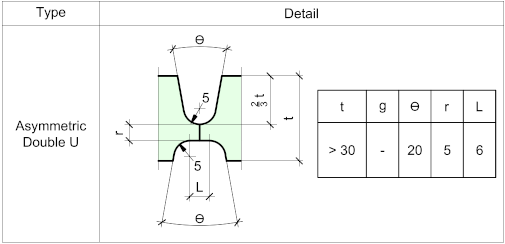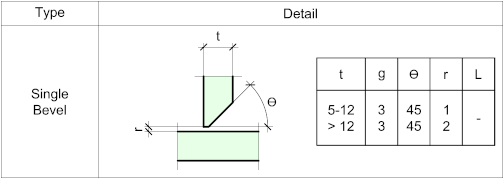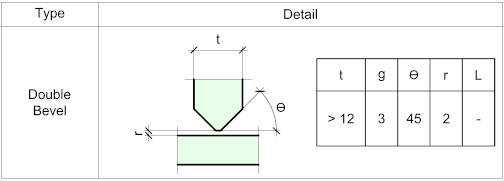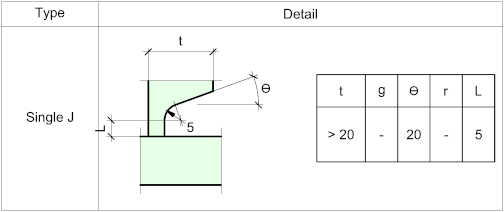 Fillet welds, as a rule do not require any special end preparation, whereas with groove welds it is generally necessary to prepare the edges of the joints to be joined so as to provide space for the weld metal to be deposited during welding. The depth of preparation depends on the loading on the joint and may equal the full plate thickness or some lesser width.
Fillet welds, as a rule do not require any special end preparation, whereas with groove welds it is generally necessary to prepare the edges of the joints to be joined so as to provide space for the weld metal to be deposited during welding. The depth of preparation depends on the loading on the joint and may equal the full plate thickness or some lesser width.
In deciding whether edge preparation is necessary, on the one hand, the cost of the preparation must be considered, while on the other, the need for increased weld penetration. When joints are not beveled, the gap between the parts is somewhat larger than for prepared ends complicating the welding procedure. Normally, only automatic welding will produce good welds in joints with no penetration. Manual welding on the other hand will require more care, and consequently, more time. Welds in joints with no penetration may result in failures owing to brittle fracture or fatigue.
The following are features of an ideal weld preparation:
- It will provide a satisfactory access throughout the depth of the weld. This is essential to ensure the deposition of sound weld metal that is properly fused to the parent metal and earlier weld deposits. In addition, it must be possible to clean the weld between runs. This is particularly important for processes where weld metal is covered by fused slag after welding.
- It minimizes the volume of deposited weld metal. Weld metal is expensive and this is an important requirement for Furthermore, the smaller the quantity of weld metal deposited, the less will be the subsequent joint distortion owing to shrinkage of the cooling metal
- Simple, plain weld preparations can be gas cut, which is considerably more economic than the machining often required for more complex preparations
- It does not lead to notches of discontinuities. This is particularly important where corrosion may be severe or where fatigue is a major design factor.
- It can accommodate the variations in fit that are likely to be encountered in practice. Thus, in the case of a groove weld between two unstiffened plates a tolerance on fit of +/- 1 to 2 mm should be achieved with reasonable care. When it comes to a joint where the elements are less flexible and the geometry is less complex, for example, a node in an offshore structure, the cost of achieving a similar fit would be prodigious. In such a situation, it would be appropriate to adopt a more tolerant welding procedure and preparation.
There are certain general principles that underlie the design of weld preparations. The most critical is the first or root pass, and the most critical part of the preparation is the root. It has to accommodate any variations in fit.
The root gap must not be so narrow that the weld pool cannot penetrate to the far side, nor must it be so wide that a weld pool cannot be established. The root face must be sufficiently deep to prevent the arc from burning through, but not so deep that there is incomplete penetration. The sizes of root gap and root face depends on the choice of welding process, welding variables, and welding position.
The root gap for a manual metal arc or CO2 semi-automatic weld would typically be between 2 and 3 mm, and the root face, between 1 and 2 mm. For a submerged arc weld, typical values might be between 0 and 2 mm, or 4 to 6 mm respectively, in view of the greater penetration achieved
If because of overall structural tolerances, the root gap cannot be maintained within acceptable limits, a metal backing strip may be used to support the weld pool in a large root gap. The disadvantage when using backing plate is that it will introduce a crevice into the weld geometry. This disadvantage can be overcome by using temporary ceramic tiles that are held in place by magnetic clamps to support the weld pool during the initial passes.
The following illustrations represent typical end preparations suitable for manual welding in the flat or down-hand position. Overhead and vertical welding positions will require manipulation of the electrode, consequently, easy access will be required for these positions. This may be achieved by using a wider angle for the weld preparation, or by increasing the root gap. Electrodes with a thick covering may require some modification to the root details.
Edge preparations for automatic welding would be different from those shown depending on the particular welding process employed.
Weld Preparations
Note! The following weld preparations are for guidance only and must be approved by the responsible engineer
Butt Welds












Tee Welds




Notes
- Dimensions in millimeters; angles in degrees
- Dimensions are for welding in the flat position. For other positions, the weld preparations may have to be modified
Reference Notes
- When t > 16, gap g may have to be increased
- For single root run
- for double root run
- If deeper V is welded first and full root penetration is required, angle on shallower V may be increased to 90° to facilitate back gouging.
